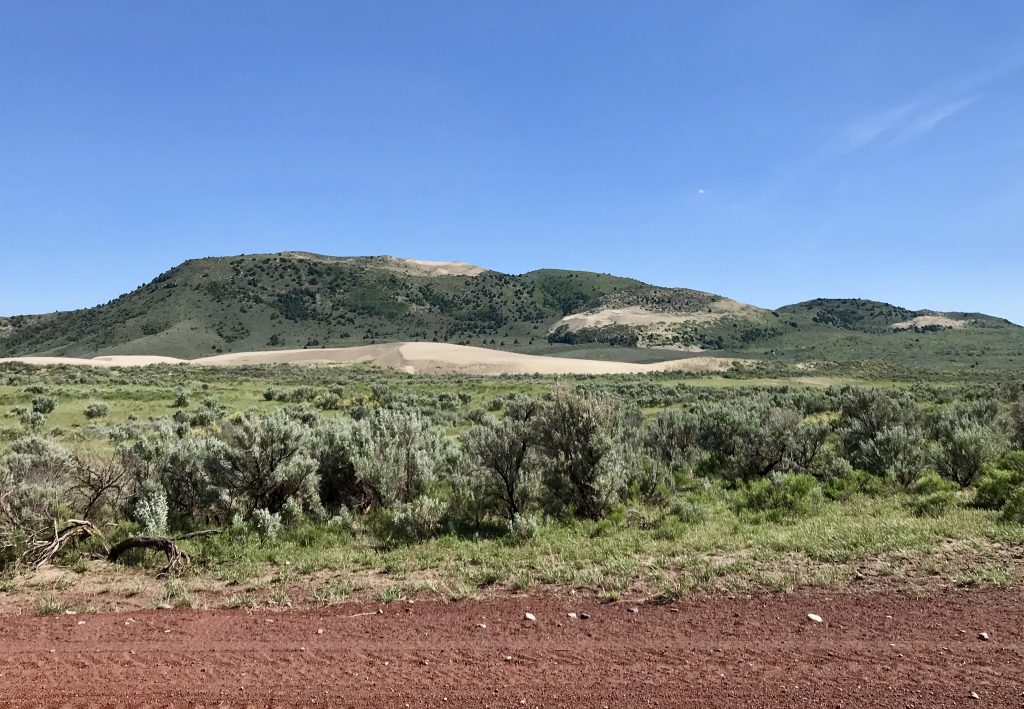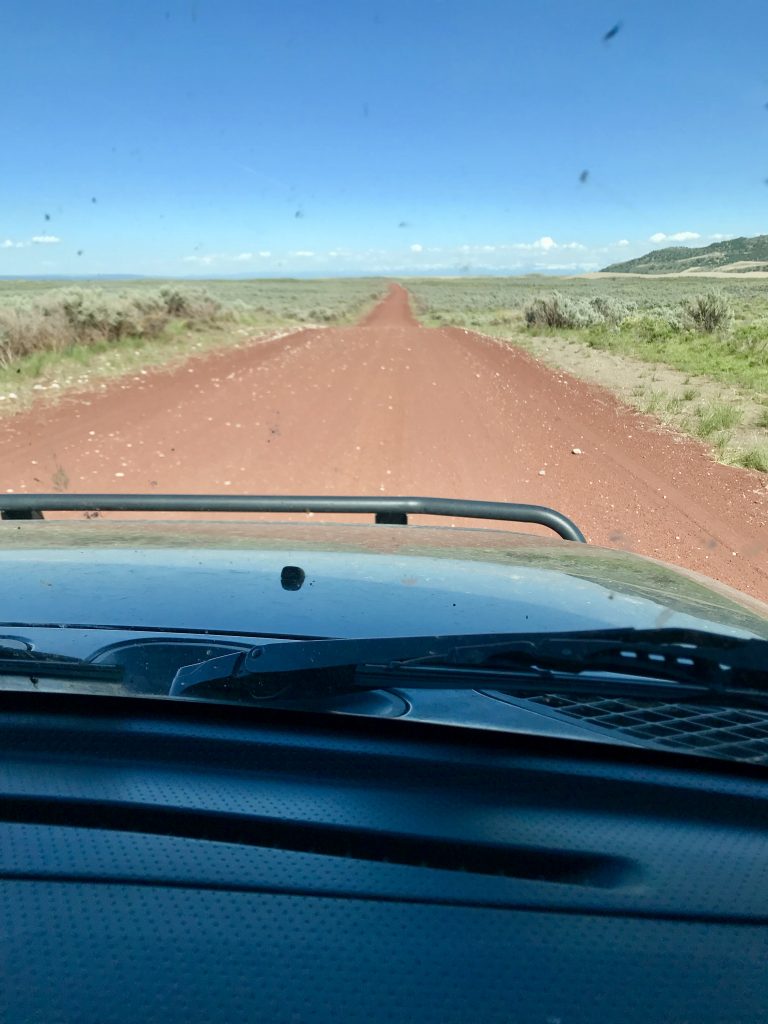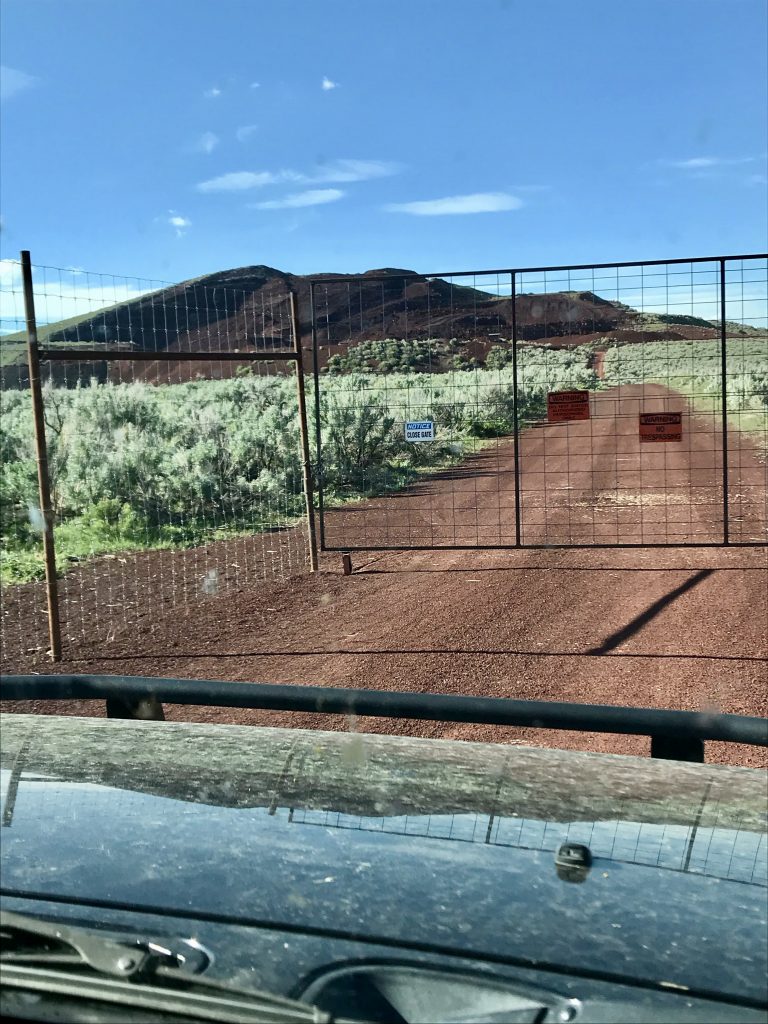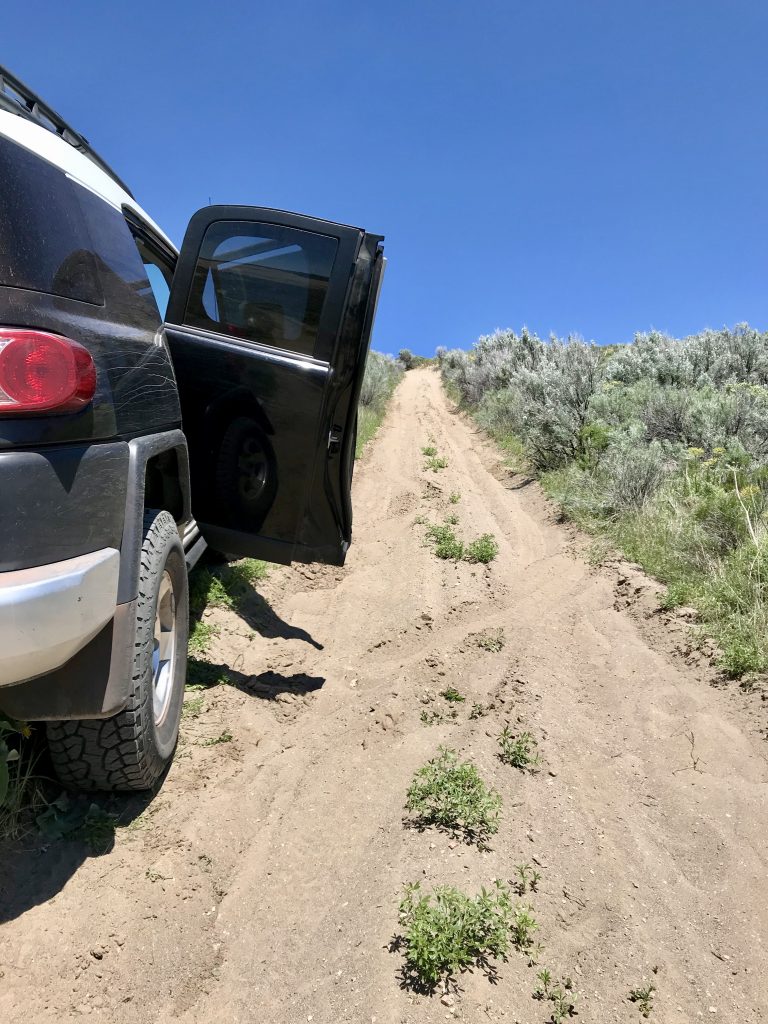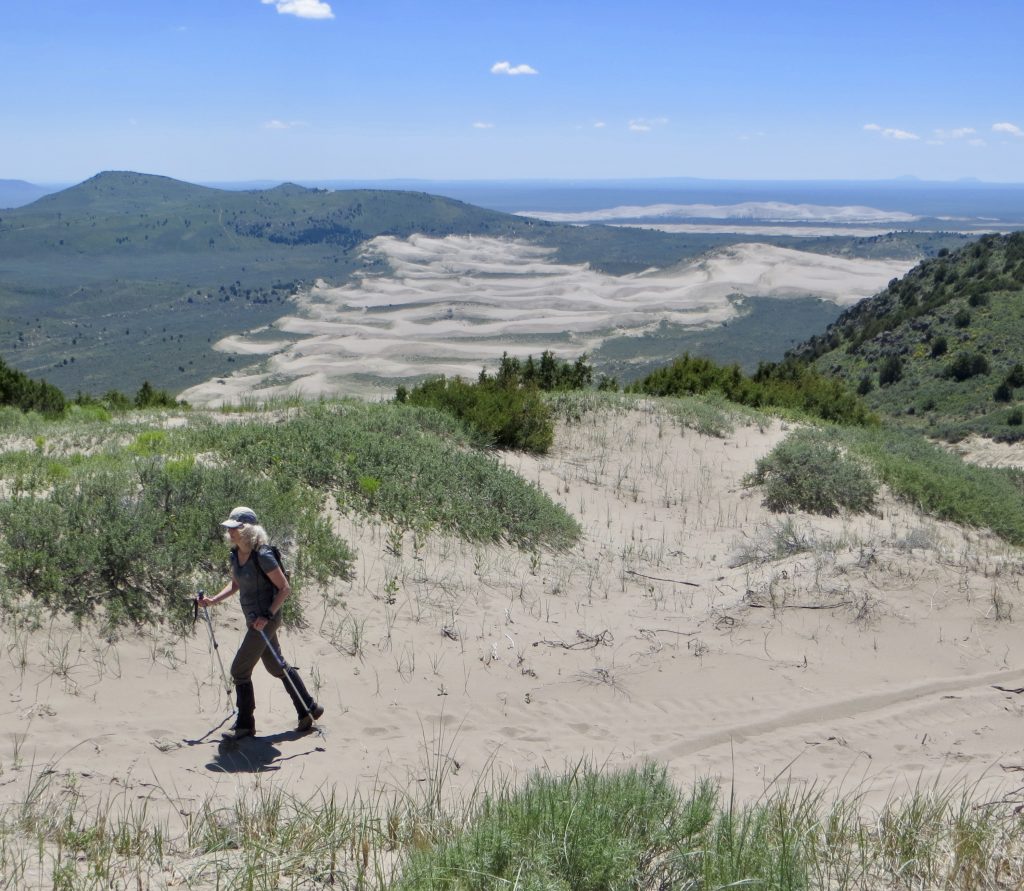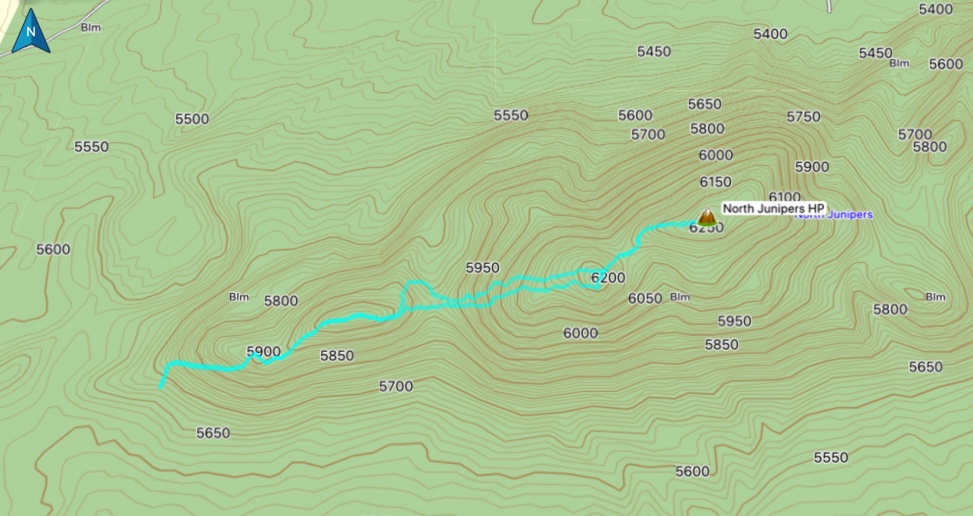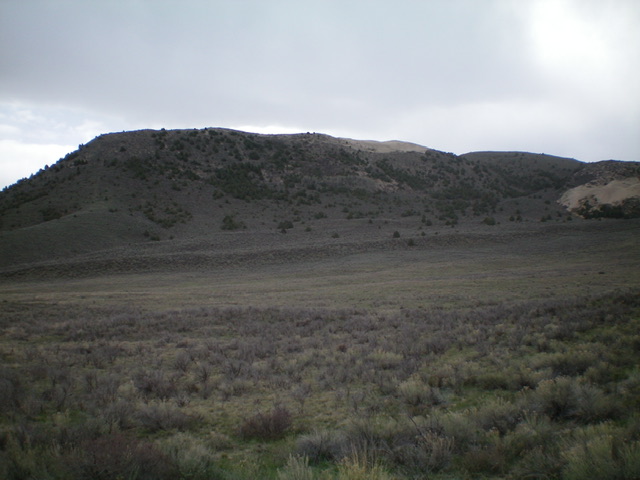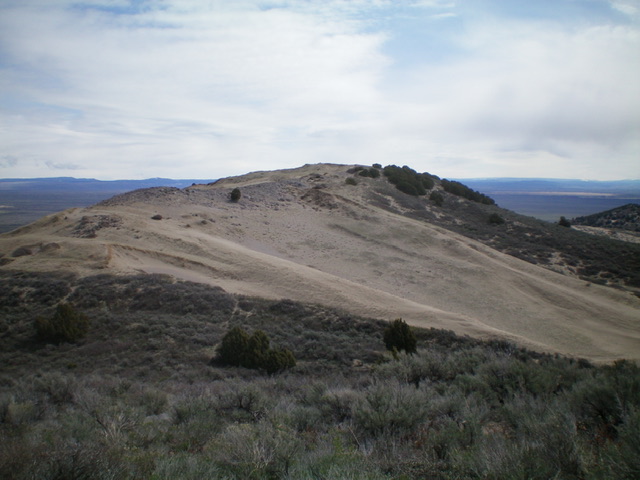Elevation: 6,265 ft
Prominence: 820
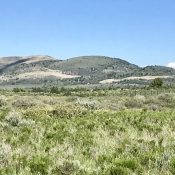
This peak is not in the book. Margo Mandella and Livingston Douglas have both provided their takes on this peak. Livingston’s submission is part of his two-peak adventure that includes Peak 5961 for those seeking to expand their climbing day to a second peak. Revised January 2025
North Junipers HP by Margo Mandella (2020)
North Junipers HP is the high point is the high point of the St. Anthony Sand Dunes, a unique geological feature in southeast Idaho with five ranked peaks. North Junipers HP is located in the North Junipers Hills area of the Sand Dunes. As described by the Bureau of Land Management (BLM):
The St. Anthony Sand Dunes consists of 10,600 acres of clear, shifting, white quartz sand. Although much of the sand dunes is managed as a wilderness study area, the area is popular for OHV use. Dunes up to 400 feet high attract riders from throughout the west. OHV users are strongly encouraged to avoid damage to vegetation and impacts to wildlife so that use of this unique area may continue. Others prefer to explore the dunes on horseback or on foot.
The dunes are heavily marketed to off-road enthusiasts and are a very popular destination and play area. We visited midweek during the off season. However, several different closures exist for this area, so check the BLM’s official St. Anthony Sand Dunes page and/or call to assure the area you want to access is open. USGS Big Grassy Ridge
We accessed this peak with a high-clearance 4WD vehicle (Toyota FJ). However, it was not the easiest to travel and we could not get as close to the peak as we planned, though we were probably lucky to get in as far as we did. Few services (i.e., gas/food) are available outside of Parker, and there are no water sources and little-to-no shade in the sand dunes. Time your trip and prepare accordingly.
Access
Access the west ridge of North Junipers HP from the northwest. Traveling from the east, south, or west, head toward Parker, Idaho. Once you reach or are near Parker, head toward the Parker-Salem Road (N 1900 E), which travels north-south and turns into Red Road. Turn west from Red Road onto Grassy Ridge Road. As you travel along this road, pass a couple of jeep trails that head SSW toward the North Junipers HP. These trails travel toward or parallel the North Junipers Hills and either braid onto other trails or dead-end, depending on the particular jeep trail.
In general, you will be “winging it” on these trails. Though on any of the jeep trails throughout the sand dunes, choices at intersections and/or hills you encounter may or may not work for you or your vehicle. We found the most direct trail to the west ridge of North Junipers HP off Grassy Ridge Road at 44.074496N, -111.892490W. Continue west on this trail as it eventually turns southwest, then south and then southeast toward North Junipers’ west ridge.
While we were still on the north side of the North Junipers on this particular trail, we had a dicey, steep climb in deep sand that we had to take a run at multiple times. At this point, we were still a long way from where we wanted to start hiking. But once we reached the top of this particular hill, we were able to drive within reasonable hiking distance of the high point. There may be another way around that avoids this hill, but we did not look for it. In general, travel is very slow going over various depths of sand, rock outcrops and rolling terrain. If you have concerns about your vehicle’s ability to navigate in sand dunes, consider renting a dune buggy. On your way to North Junipers HP, you can also climb Peak 5961 a little farther to the west of the jeep trail.
West Ridge, Class 2
If you make it to the base of the west ridge, use the jeep trail and climb the first ascent on the ridge. Here, find a trail to the east with a signed closure (no motorized travel) that continues upward. This trail makes for easy travel for the first part of the climb. When the trail begins to disappear, continue off-trail and pick your route toward and over a false summit. Here you will clearly see the true summit and you can hike your way to it. Trip stats: 3.1 miles with 820 feet of elevation gain round trip.
North Junipers HP by Livingston Douglas (2022)
North Junipers HP is the highest peak in the St. Anthony Sand Dunes Area west of Parker, Idaho. It is most easily reached from Grassy Ridge Road to its north. The roads leading to the north side of North Junipers HP are quite good. This area is a mix of private and public land, so be careful. This is the first leg of a 2-peak adventure that includes North Junipers HP and Peak 5961. It avoids the dubious, 2-track side roads that might leave you stuck in deep sand with no place to turn around. This journey covers 11.0 miles with 1,850 feet of elevation gain round trip. USGS Big Grassy Ridge
Access
Grassy Ridge Road (unsigned) is reached from Red Road. Red Road is a north-south paved road that is located west of Parker, Idaho. It can be reached from Parker via West 4th North Road or via South Parker Road/500N. Follow either road west to its junction with [signed] Red Road, which is signed as 1900E. From the south, Red Road can be reached on US-20 in North Rexburg (Exit 337). After exiting US-20, turn left/north onto [unsigned] Salem Road which becomes Red Road. Drive 6.1 miles north on Salem/Red Road to its signed junction with 500N.
From the signed junction of 500N and 1900E (Red Road), drive north on Red Road (a paved, 50MPH road) for 8.2 miles to an unsigned junction with Grassy Ridge Road (a wide, well-maintained gravel/red dirt road). Ironically, Red Road is not red at all. It is a paved, blacktop highway. Grassy Ridge Road is a road of red gravel/dirt. Grassy Ridge Road is the true “red road.” Reset your odometer at the junction of Grassy Ridge Road and Red Road.
At 3.4 miles, reach an unsigned junction (at 5,397 feet on the map) with a side road that is posted and goes left/south onto private ranch land. This side road heads almost directly south at the summit of North Junipers HP. It is a useful landmark. At 3.6 miles, reach an unsigned side road(s) that lead left/north a short distance to a parking area and multiple ATV trails. Park here (5,410 feet). This is the most direct route to North Junipers HP.
If you drive a bit farther along Grassy Ridge Road to a road junction at 4.2 miles, you reach a junction with a southbound jeep road with a “Camping Regulations” sign near its base. Park at this junction (5,413 feet on the map) or drive a short distance south on the rutted dirt road (which may be impassable due to mud holes and ruts) a short distance to an open camping area and park there. This route is slightly longer but requires less off-trail sagebrush bushwhacking than the aforementioned side road at the 3.6-mile point on Grassy Ridge Road.
Northwest Face, Class 2
The Climb
From the parking area at 5,410 feet, scramble southwest along the left/east side of a series of sand dunes. Be sure to stay right/west of the cattle fence that separates BLM land from private ranch land. This is a somewhat tedious endeavor due to some ups and downs, unpleasant side-hilling on steep terrain,loose sand, and sagebrush. After about 1.5 miles of effort, pass the sand dunes and reach a corner in the fence row. Find an ATV road for the final section of the bushwhack southwest. Head left/east along the fence row and skirt the left/north side of a prominent buttress near Point 5510.
Once past the buttress, bushwhack through sagebrush and cross 2-3 minor dry gullies to reach the base of the [obvious] intimidating northwest face of North Junipers HP. From here, there are two options. Either follow the primary, sandy, brushy gully south then southeast up onto the summit ridge and then follow the west ridge to the top OR climb directly southeast up the face to the summit. I chose the latter option. The northwest face is a steep, sandy mix of junipers, aspen, and sagebrush initially then a mix of sand and short grass higher up. Though a bit tedious, it goes quickly and leads directly to the summit area. There was no cairn on the summit, which sits atop a narrow ridge line. It is clearly the high point even though the southwest summit is only 34 feet lower (6,231 feet).
South Gully, Class 2
The Descent
From the summit, descend the ridge southwest to a saddle then up 100 vertical feet over Point 6231 amidst much sagebrush and sand. From Point 6231, descend west to a prominent gully that heads south down to a wide, sagebrush valley. Bushwhack through sand and sagebrush to reach an ATV road that cuts through the middle of the sand-and-sagebrush valley. This is the low point of the traverse to Peak 5961 and concludes the first leg of today’s 2-peak journey. Peak 5961 is up next.
Additional Resources
